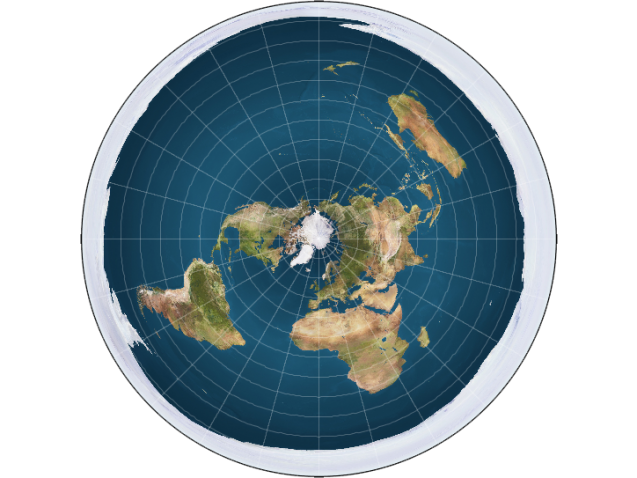What Would Happen if the Earth Were Actually Flat?
You could say goodbye to the atmosphere and GPS navigation, to start.

Welcome to the new year, 2018. The Earth has yet again made a revolution about the sun. But not so fast. If you subscribe to the idea of a flat Earth, then you’d believe that no such thing happened, because the sun rotates in a circle around the sky.
Humans have known for thousands of years that the planet is round, yet the belief in a flat Earth refuses to die. Members of the Flat Earth Society and several celebrities, including Atlanta rapper B.o.B and NBA player Kyrie Irving, claim to hold such beliefs. Let’s examine, then, how the well-known principles of physics and science would work (or not) on a flat Earth.
Gravity Fails
First of all, a pancaked planet might not have any gravity. It’s unclear how gravity would work, or be created, in such a world, says James Davis, a geophysicist at Columbia University’s Lamont-Doherty Earth Observatory. That’s a pretty big deal, since gravity explains a wide range of Earthly and cosmic observations. The same measurable force that causes an apple to fall from a tree also causes the moon to orbit the Earth and all the planets to orbit the sun.
People who believe in a flat Earth assume that gravity would pull straight down, but there’s no evidence to suggest it would work that way. What we know about gravity suggests it would pull toward the center of the disk. That means it would only pull straight down at one point on the center of the disk. As you got increasingly far from the center, gravity would tug more and more horizontally. This would have some strange impacts, like sucking all the water toward the center of the world, and making trees and plants grow diagonally, since they develop in the opposite direction of gravity’s pull.
Solar Problems
Then there’s the sun. In the scientifically supported model of the solar system, the Earth revolves around the sun because the latter is much more massive and has more gravity. However, the Earth doesn’t fall into the sun because it is traveling in an orbit. In other words, the sun’s gravity isn’t acting alone. The planet is also traveling in a direction perpendicular to the star’s gravitational tug; if it were possible to switch off that gravity, the Earth would shoot away in a straight line and hightail it out of the solar system. Instead, the linear momentum and the sun’s gravity combine, resulting in a circular orbit around the sun.
The flat Earth model places our planet at the center of the universe, but doesn’t suggest that the sun orbits the Earth. Rather, the sun circles over the top side of the world like a carousel, broadcasting light and warmth downward like a desk lamp. Without the linear, perpendicular momentum that helps generate an orbit, it’s unclear what force would keep the sun and moon hovering above the Earth, Davis says, instead of crashing into it.
Likewise, in a flat world, satellites likely wouldn’t be possible. How would they orbit a plane? “There are a number of satellite missions that society depends on that just wouldn’t work,” Davis says. For this reason, he says, “I cannot think of how GPS would work on a flat Earth.”
If the sun and moon just loop around one side of a flat Earth, there could presumably be a procession of days and nights. But it wouldn’t explain seasons, eclipses and many other phenomena. The sun would also presumably have to be smaller than Earth so as to not burn up or bump into our planet or the moon. However, we know the sun to be more than 100 times the diameter of the Earth.
Removing Heaven and Earth
Deep below ground, the solid core of the Earth generates the planet’s magnetic field. But in a flat planet, that would have to be replaced by something else. Perhaps a flat sheet of liquid metal. That, however, wouldn’t rotate in a way that creates a magnetic field. Without a magnetic field, charged particles from the sun would fry the planet. They could strip away the atmosphere, as they did after Mars lost its magnetic field, and the air and oceans would escape into space.
Tectonic plate movement and seismicity depend on a round Earth, because only on a sphere do all the plates fit together in a sensible way, Davis says. Movements of plates on one side of the Earth effect movements on the other. The areas of the Earth that create crust, like the mid-Atlantic ridge, are counterbalanced by places that consume crust, like subduction zones. On a flat Earth, none of this could be adequately explained. There’d also have to be an explanation for what happens to plates at the edge of the world. One could imagine they might fall off, but that would presumably jeopardize the proposed wall that prevents people from falling off the disk-shaped world.

Perhaps one of the most glaring oddities is that the proposed map of the flat Earth is totally different. It places the Arctic at the center while Antarctica forms an “ice wall” around the edges. In such a world, travel would look very different. Flying from Australia to certain parts of Antarctica would, for example, take forever—you’d have to travel over the Arctic and both Americas to get there. In addition, certain real-world feats, such as traveling across Antarctica (which has been done many times), would be impossible.
Falling Flat
Contrary to popular belief, it’s a misconception that many societies of serious, educated people ever actually believed in the flat Earth theory. “With extraordinary few exceptions, no educated person in the history of Western Civilization from the third century B.C. onward believed that the Earth was flat,” historian Jeffrey Burton Russell noted in 1997. “A round Earth appears at least as early as the sixth century B.C. with Pythagoras, who was followed by Aristotle, Euclid, and Aristarchus, among others in observing that the earth was a sphere.”
As the scientist and writer Stephen Jay Gould once wrote, the idea that many people—including the Spaniards and Christopher Columbus—believed the Earth to be flat was largely concocted by 19th century writers such as Washington Irving, Jean Letronne and others. Letronne was “an academic of strong anti-religious prejudices… who cleverly drew upon both to misrepresent the church fathers and their medieval successors as believing in a flat earth,” Russell noted.
In any case, while it’s fun to imagine counterfactual scenarios, science proceeds by coming up with theories to explain observations. When it comes to these theories, the simpler, the better, Davis says. The flat Earth idea, however, clearly begins with the idea that the planet is planar, and then attempts to twist other observations to its benefit. You can find odd explanations for individual phenomena under this framework, says Davis, but “it falls apart pretty quickly.”
